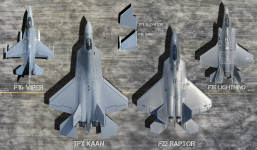I am aware of it. Peripheral radar coverage concept is nothing new, going as far back as the Su-27M project in the 90s.
While obviously technological limitation and doctrinal differences exists, generally speaking EODAS based awareness suite is more flexible and capable than peripheral radar coverage. Allow me to explain.
EODAS, or Electro-Optical Distributed Aperture System, integrates the functions of IR, UV, and TV band apertures that also fulfills the function of IRST and MAWS. This not only means the pilot wearing HMD can "see through the fuselage" as AR function for the HMD can display EO images of the corresponding aperture distrubuted around the fuselage, this also allows the jet to gain 360 IR and UV awareness, from engine exhausts to missile trail, to the subtle heat signature generated by airframes and missiles experiencing air friction at ranges between 20-60km given the environmental condition - this is often enough to generate a valid firing solution even against VLO targets like a peer stealth fighter, hence why advanced missiles like AIM-120D, AIM-9X, PL-15, and PL-10 have "over-the-shoulder" firing ability, as they can be slaved directly by EODAS via datalink. What's more, the entire system is entirely passive, as in it doesn't generate any electronic signature for enemy ELINT to pick up, which is very important in a peer to peer environment.
Peripheral AESA radar coverage is most notably employed by the Su-57 to make up for the shortcomings that Russia have in advanced EO systems and to suit its needs to patrol large, unpopulated and undefended airspace, that the peripheral radars operating in L or S bands, while not likely to achieve valid firing solutions of their own, is enough to act as early warning and long range survaillence, and in VKS' vision, Su-57 would act as (relatively) high-survivability awareness nodes, directing conventional platforms like Su-35S as well as future platforms like S-70 Okhotnik drones. This have several weaknesses, 1. obviously you have less systems integration, as you still need IRST and MAWS 2. you are more vulnerable to ELINT, as for radars, you need to send radio waves to receive it, and against most peer platforms, if you can see them, they can definetly see you 3. Your HMD is only responsible for cueing for EOTS and IRST, and does not provide 360 degrees vision awareness for the pilot.
Again, this is all very much subject to change as TAI Kaan continues to evolve.










